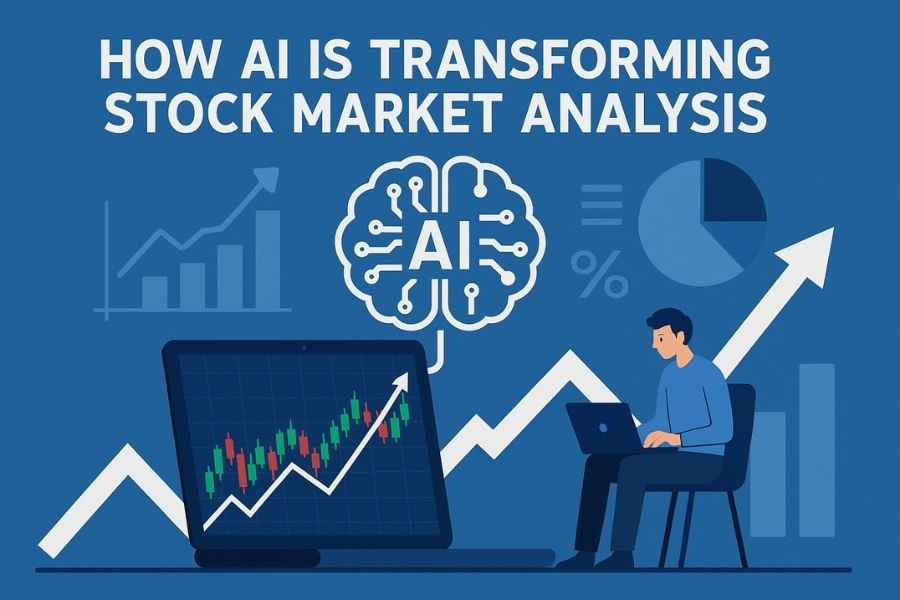The New Frontier
In the fast-changing arena of global finance, technology is now the pulse of innovation. Of the most potent forces shaping the investment environment of today, one is Artificial Intelligence (AI). From facilitating a better understanding of data to more nuanced risk determinations, AI is transforming how stock market analysis is being performed, particularly across emerging economies as well as old-world economies alike.
In the following article, we discuss how AI is revolutionizing stock market analysis in a straightforward, informative manner for investors interested in making sense of these ever-changing developments. We further analyze the influence of AI on other financial instruments, such as CFDs metals trading, without providing investment advice.
The Evolution of Stock Market Analysis: A Brief Overview
Historically, stock market analysis has been based on human judgment, analysts pored over balance sheets, tracked economic news, and read technical charts to forecast market action. Though effective to some degree, human analysis is inherently constrained by cognitive biases and processing capacity.
The advent of AI has dramatically changed this paradigm. Machine learning algorithms, predictive analytics, and natural language processing (NLP) capabilities now augment or even supplant human analysis, enabling quicker, more thorough, and possibly more objective market intelligence.
How AI is Changing the Game
1. Big Data and Predictive Analytics
Today’s markets create enormous amounts of data every second. Conventional analytical techniques can no longer keep pace, but AI is well suited to data-rich environments. Machine learning algorithms can consume structured and unstructured data, ranging from financial reports and press releases to social media sentiment and satellite imagery, and identify patterns that may not be within human analysts’ capabilities to discern.
Investors can look into applying AI-based platforms that utilize predictive analytics to simulate different market possibilities. Although they are not always accurate, the models can pinpoint potential opportunities or alert to possible risks sooner than traditional approaches.
2. Better Algorithmic Trading
Algorithmic trading, often referred to as “algo-trading,” leverages AI to execute trades at optimal times based on predefined criteria. Advanced AI systems can adapt strategies in real-time, learning from market conditions to optimize performance.
For example, in trading CFDs (Contracts for Difference), a derivative instrument that enables speculation in price movements without the underlying asset, AI can be used to determine dynamic stop-loss levels and adjust positions in response to changing volatility levels. In the same way, AI increasingly contributes to metals trading, where algorithms monitor supply-demand patterns, geopolitical events, and macroeconomic indicators to forecast price fluctuations.
Of note is the fact that while algorithmic trading can provide speed and efficiency, it does come with risks, which consist of heightened market volatility and flash crashes. Responsible use and stringent regulation are thus imperative.
3. Sentiment Analysis and Behavioral Insights
Sentiment analysis technologies fueled by AI scour large tracts of web content, news stories, earnings call transcripts, social media messages, to monitor market sentiment. Behavioral insights derived from such analyses assist investors in comprehending how emotions and aggregate sentiment could influence price action.
Most notably in the turbulent industries like metals trading, where prices are subject to significant extraneous influences like geopolitical occurrences and macroeconomic volatility, sentiment can add another angle of strategic insight.
But sentiment is volatile by nature and can reverse quickly, so investors are well-advised to blend AI-based sentiment signals with other analysis techniques for a rounded strategy.
4. Fraud Detection and Risk Management
Historically, risk assessment has depended on past data and laborious stress testing. AI introduces a more dynamic, dynamic approach through real-time data to recurrently revaluate risk profiles.
Machine learning algorithms are capable of tracking trading patterns, recognizing abnormal patterns, and flagging potential market manipulation or fraud. In leveraged derivative markets such as CFDs, where both gains and losses are multiplied by leverage, AI-powered risk management tools can become a critical component in protecting capital.
Additionally, banks around the world are increasingly using AI to comply with stringent regulatory standards, providing transparency and safeguarding investors against systemic risks.
The Global Impact: Emerging Markets and Beyond
The impact of AI is not limited to the developed economies. Emerging markets in Asia, Latin America, and Africa are also fast embracing AI technologies to bring modernity to their financial markets. Advanced AI technologies assist participants in these markets to deal with issues like data shortage, fragmentation of regulations, and liquidity problems.
While certain jurisdictions are confronted with infrastructural challenges, mobile technology uptake and digital financial ecosystems are creating a leapfrogging phenomenon, enabling such markets to incorporate advanced AI solutions more quickly than conventional markets.
Investors need to be aware, however, of the distinctive risk profiles that come with emerging markets, such as political risk and currency risk. AI can help model such risks but not eradicate them.
Challenges and Ethical Considerations
Although the advantages of AI in stock market analysis are significant, they are accompanied by significant challenges:
- Data Privacy and Security: Greater dependency on data means greater concerns over privacy and cyber attacks.
- Algorithmic Bias: AI algorithms based on biased data can amplify or even reinforce current market inefficiencies.
- Regulatory Uncertainty: Various jurisdictions are developing their frameworks at different speeds, causing compliance issues.
Ethically deploying AI requires disclosure, responsibility, and constant monitoring to ensure that the technology benefits the wider financial system in a fair manner.
The Future of Stock Market Analysis with AI
In the future, AI will most probably become further entrenched in the analysis of the stock market. Breakthroughs like explainable AI (XAI), aiming to make AI decisions more interpretable to their human users, and quantum computing, which could potentially exponentially accelerate data processing power, are looming on the horizon.
Investors can search for platforms and tools that lead the way on ethical AI adoption, compliance, and effective risk management procedures. Human judgment, as ever, will be vital, to accompany AI intelligence and develop comprehensive investment strategies.
Conclusion: Striking a Balance
Artificial Intelligence is transforming stock market analysis by providing quicker, smarter, and more detailed insights. In conventional equity markets and CFD metals trading, AI-powered tools are becoming essential parts of the contemporary investor’s arsenal.
But, as with all revolutionary technologies, AI has to be used wisely. Its capabilities, and its limitations, need to be understood. Investors everywhere, and especially those working through the complexities of the emerging markets, might find that an even-handed strategy marrying AI innovation with human acumen presents the best way forward.
As the world of finance continues to grow and change, those who embrace AI responsibly may be better positioned to navigate the future of investing with more insight and clarity.
Disclaimer: The information is provided for educational purposes only and doesn’t take into account your personal objectives, financial circumstances, or needs. It does not constitute investment advice. We encourage you to seek independent advice if necessary. The information has not been prepared in accordance with legal requirements designed to promote the independence of investment research. No representation or warranty is given as to the accuracy or completeness of any information contained within. This material may contain historical or past performance figures and should not be relied on. Furthermore estimates, forward-looking statements, and forecasts cannot be guaranteed. The information on this site and the products and services offered are not intended for distribution to any person in any country or jurisdiction where such distribution or use would be contrary to local law or regulation.




